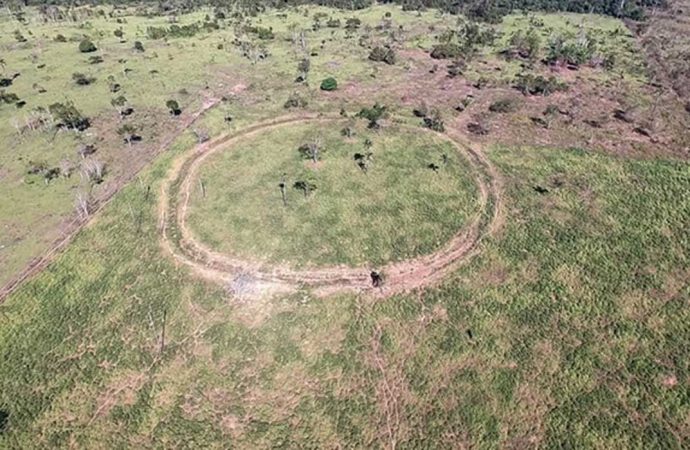Archaeologists are discovering that the Amazon region was not a pristine place before European contact.
In fact, a new study suggests that there was quite a large population living there. What evidence can we see for their villages today? The outlines of their settlements and a few hardy artifacts.
Just over a year ago, large geometric earthworks (geoglyphs) in the southwestern Amazon made international headlines as both an unexpected discovery and for the resemblance of some sites to the famed Stonehenge. They are estimated to be at least 2,000 years old.
Called the Geoglyphs of Acre because most of them are located in the Brazilian State of Acre, nearly 500 locations were identified. They come in various shapes: squares, circles, U-forms, ellipses, and octagons; but researchers believe that they all enhanced the connection between humans and nature. Their very existence shows that humans were in the Amazon much earlier than once believed – although the impact they had certainly is nothing compared to the levels of destruction seen today.

Examples of geoglyphs and mounded ring villages in the Amazon: a. LiDAR digital terrain model of the Jacó Sá site. b. Aerial photo of one of the structures at Jacó Sá site. c. Aerial photo of Fonte Boa site. (CNPq research group Geoglyphs of Western Amazonia/ Denise Schaan )
Now there is mounting evidence that humans ventured into other parts of the Amazon as well. The Chicago Tribune reports that 81 geoglyphs have been found in the upper Tapajós Basin, a “transitional zone” where Brazil borders Bolivia. This area receives less rainfall than lower regions and is also called terra firme. It is a place that rarely floods and a location which archaeologists have largely ignored in favor of more fertile regions closer to large rivers.
Jonas De Souza of the University of Exeter, UK collaborated with other scientists Britain and Brazil to explore a terra firme region which has been forgotten, despite being bordered on the east and west with archaeological sites. According to The Guardian , the new sites were first noted in deforested areas by satellite imagery.
The newly identified earthworks show signs of ditch enclosures, sunken roadways, and earth platforms and vary from small 30 meter (98.43 ft.) wide villages to immense 19-hectare settlements.

Ditched enclosures of the Upper Tapajós Basin (UTB). ( Google, DigitalGlobe )
The possibility was too exciting to leave at satellite image analysis, so researchers set off to explore 24 of the sites on the ground. De Souza told The Guardian, “Everything that we identified on satellite imagery that we tested was an archeological site.” The results published in Nature Communications shows that the trip was worthwhile. The authors write :
“The results of our predictive model of ditched enclosures show that, despite the enormous distances covered, earthworks are found across areas of notable environmental similarity, with pronounced seasonality in rainfall and temperature […] The seasonal drought of the transitional forests of this region probably facilitated clearance for the construction of earthworks. The easy-to-clear vegetation and the more fertile/less weathered soils of seasonally-dry forests are factors that made them attractive to Pre-Columbian farmers.”
De Souza said that the team found artifacts such as ceramics and polished stone axes, and also dark fertile earth which comes with extended human habitation. No buildings have been detected, but that’s not surprising because they were probably made of wood. Charcoal found near the ceramics at the sites has been carbon dated to 1410 – 1460 AD, in line with sites in the southern part of the Amazon, which were most active between 1250 and 1500.

Site Mt20. ( José Iriarte )
One of the most startling results of the research is the claim based on models that 500,000 to a million people were living in that part of the Amazon and they may have built some 1,000 to 1,500 enclosures! De Souza clarified , “It’s probably the case that some areas of the Amazon were sustaining large populations and others were not. Because there is so little research, we are slowly discovering what was happening in each.”
That large of a population would have certainly meant modification to the rainforest, but de Souza pointed out ,
“The forest is an artifact of modification. It has nothing to do with the kind of practice we are seeing nowadays – large-scale, clearing monoculture. These people were combining small-scale agriculture with management of useful tree species. So it was more a sustainable kind of land use.”

Amazon Rainforest, Brazil. (Ben Sutherland/Darren and Sandy Van Soye/ CC BY NC SA 2.0 )
Although the numbers may appear high at first, they seem to fit with accounts given by the first Europeans who entered the Amazon. Those reports were mostly discredited by historians as fantasy. Now archaeological evidence is giving the early travelers some support.
But the European arrival meant devastation for many of the settlements, as de Souza said , “We know that diseases travelled much faster than people and probably this population was already weakened by diseases brought by Europeans even before the Europeans set foot on the area.”
Source: Ancient Origins

































Leave a Comment
You must be logged in to post a comment.